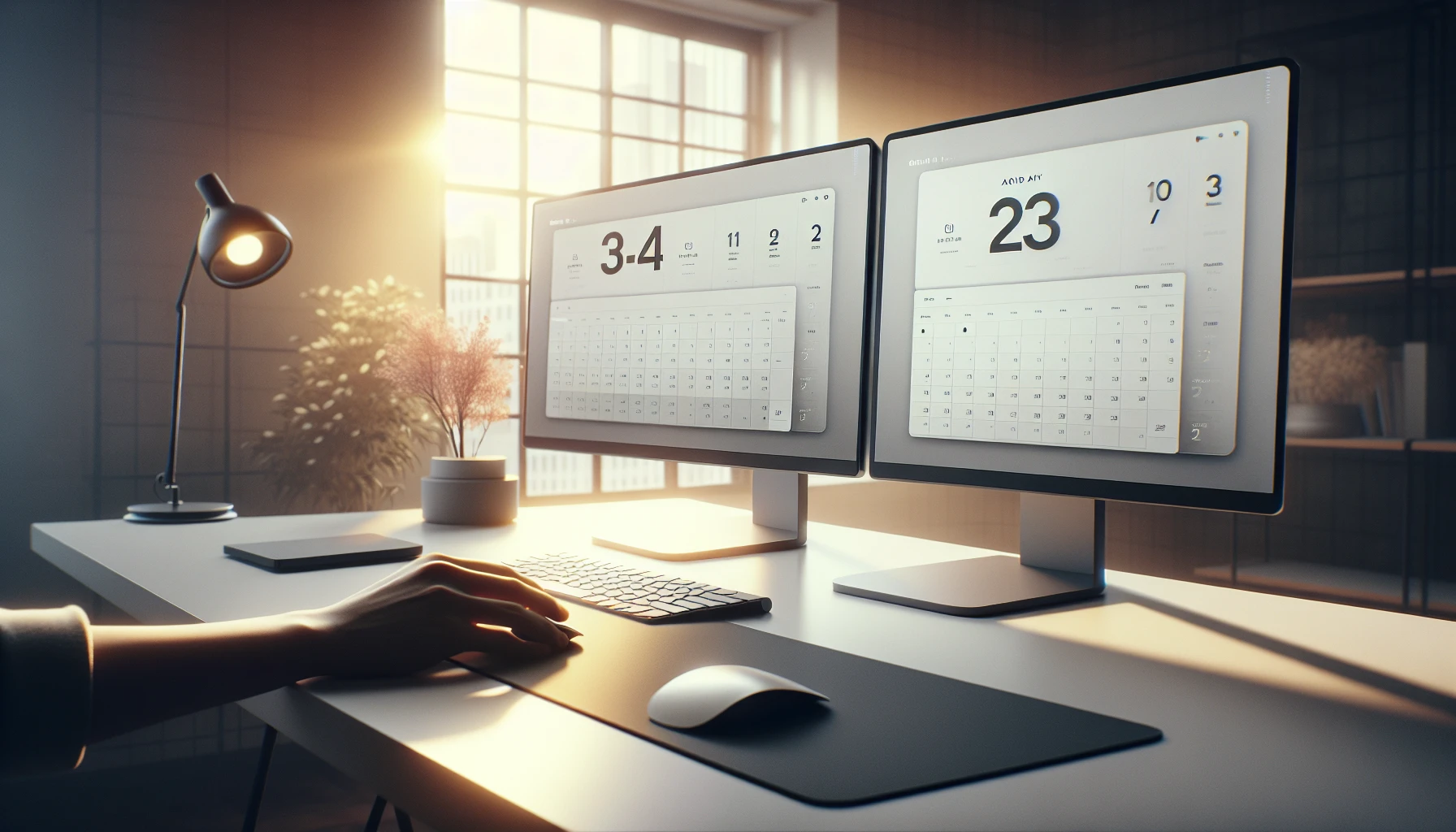· Ricardo Batista · 14 min read
Automated vs manual meeting reminders - How to Save Time
Manage meeting reminders with tools like Google Calendar and simple scripts, easing schedule tasks, cutting missed meets & boosting client talks.

Meeting reminders now mix manual touch with automation. This guide talks about using everyday tools like Google Calendar and Google Apps Script to simplify scheduling and cut down no-shows, helping you balance old and new methods. Find out how merging both techniques can ease your daily appointment hassle and boost interactions with clients and friends alike.
Key Takeaways
- Easily mix manual and automated reminders to boost your meeting efficiency
- Learn simple ways to set up reminders using tools like Google Calendar and Google Apps Script
- Our expertise shines through with our ability to automatically ping attendees that arrive late to your meetings
- Understand the benefits and drawbacks of both reminder types, so you know what’s best for your team
- Use clear and simple setups so your meeting schedules stay organized, reliable and easy to manage
Automated Versus Manual Meeting Reminders: A Detailed Look
Automating meeting reminders is trending fast these days, especially when you consider how much easier it makes scheduling, tracking, and following up with attendees. People often compare automated methods to manual processes, and each has its own set of benefits and challenges to deal with. Below, we dive into the pros and cons when scheduling appointments and recurring events, and we also outline how to set up automated reminders with common tools. This guide covers tools like Google Sheets, Google Calendar, and Google Apps Script, and it shows you simple yet effective steps to automatically send annual notifications, emails, and scheduling tasks.
Pros and Cons of Automation for Meeting Reminders
Benefits of Automated Reminders
Automated reminders help cut down the workload and eliminate human error that comes with manual processes. Some clear benefits include:
- Reducing No-Shows: Automatically pinging attendees can significantly lower the chance of missed meetings.
- Boosting Revenue: Fewer missed appointments mean better meeting attendance, which can lead to improved customer service and better business outcomes.
- Cutting Administration Time: Automation frees up your schedule by reducing the need to manually send out reminders or follow-ups.
- Standardized Communication: With automation, every reminder stays consistent. This removes the risk of any oversight or accidental omissions.
Automated systems will also send out instant notifications if someone is running late. That feature can be useful for teams that spend a lot of time waiting or adjusting meeting times. It ensures everyone is kept in the loop in real time, relying on tools that can quickly send SMS or email alerts.
Potential Downsides and Challenges
Even though the benefits are clear, there are some challenges that come with automated systems:
- Initial Setup Complexity: It could take a while to properly set up automation tools, especially if you’re new to systems like Google Apps Script.
- Technical Glitches: Automated tools might occasionally misfire, sending notifications at the wrong times, which can be confusing.
- Perceived Impersonal Touch: In some cases, especially for smaller teams, automated reminders may feel less personal. Manual checks and a note of empathy can sometimes be more effective.
- Flexibility Limits: Automation works on set parameters and might not easily adapt if a meeting schedule changes last minute or if there are unique requirements for certain appointments.
While manual reminders give you more control, they are more time-consuming and can lead to mistakes. When it comes to recurring meeting reminders, automated tools really shine, especially if you’re managing multiple events or large teams.
Step-by-Step Guide: Automating Meeting Reminders with Google Tools
If you’re interested in setting up automated meeting reminders, tools provided by Google are a strong starting point. Here’s a step-by-step approach to help you create a system that works for annual or recurring events.
Setting Up with Google Sheets and Google Calendar
Prepare Your Google Sheet:
- Create a new spreadsheet.
- Include columns for meeting details such as date, time, attendees, and any other relevant notes.
- Use this sheet as your main database for appointment details.
Integrate with Google Calendar:
- Open Google Calendar and create events that align with your sheet data.
- Use the description or notes field in the calendar for additional information linked to the event.
- Ensure that the event settings include reminders or notifications for both the host and the participants.
Connecting the Two Tools:
- You might consider using third-party tools or simple Google Apps Script code to link your Google Sheet with Google Calendar.
- The idea is to have changes in the sheet automatically update the calendar events.
- This ensures that if an event is rescheduled or updated in the Google Sheet, the calendar follows suit.
Using Google Apps Script for Automation
Google Apps Script is a powerful tool that can help automate the process of sending reminders or updating meeting data. Here’s a basic outline to get you started:
- Open your Google Sheet and go to Extensions → Apps Script.
- Write a simple script that reads data from your spreadsheet and creates or updates Google Calendar events.
- Set up triggers so the script runs at specific intervals or when changes are detected in your sheet.
- Include logic in your script to send follow-up emails or even SMS notifications via integration with third-party services.
For those who are new to scripting, Google provides plenty of tutorials and templates in their Apps Script documentation. Experiment with small scripts first, then gradually build towards more complex functions as you become comfortable with the coding environment.
Example Code Snippet (Simplified)
Below is an example snippet in pseudocode format that outlines how you might set up a trigger in Google Apps Script:
- Open the script editor in Google Sheets.
- Use code similar to:
- Identify events in your Google Sheet.
- Locate corresponding events in Google Calendar.
- If an event time is approaching and a confirmation has not been received, send an email reminder.
- Check if the attendee has already been flagged as late; if so, trigger an SMS notification (this might need a third-party service integration).
While the above is a simplified overview, it represents the basic logic behind automating meeting reminders.
Real-World Applications and Integration with CRM Systems
Many organizations pair automated meeting reminders with CRM platforms like Salesforce and Hubspot. This approach ensures that client data, meeting history, and follow-up actions are seamlessly coordinated. Here’s how you can benefit from integrating reminders with CRMs and messaging systems:
Integration Benefits
- Enhanced Customer Experience: Automated carousels of notifications can guide customers through their meeting schedules efficiently.
- Effective Follow-Up: Once a meeting is over, automated reminders can trigger follow-up activities like thank-you emails or survey invitations.
- Streamlined Data Entry: By integrating with CRM systems, meeting details automatically populate client records, saving time and minimizing mistakes.
- Improved Reporting: Combined data from reminders and CRM systems can offer insights into the rates of attendance, client engagement levels, and overall meeting statistics.
Tools and Templates to Consider
- Several platforms offer both CRM integrations and automatic notification systems. For instance, Calendar Meeting Reminders provide templates and demos that help set up a system from scratch.
- There are also specific tools like Appointment Reminder that are dedicated to handling recurring notifications across SMS and email channels.
- Most modern CRM systems have plugins or APIs that allow for a two-way sync. This helps in keeping the calendar and client information updated and prevents errors during critical meetings.
Messaging Systems: SMS and Email
Using both SMS and email simultaneously is a widely adopted practice. It ensures that notifications reach the recipients wherever they are. Here is how you might combine these systems effectively:
- Email Notifications: Email is perfect for detailed information, attaching agendas, or providing directions and supplementary details about the meeting.
- SMS Alerts: SMS notifications are ideal for instant communication—like pinging someone as they arrive late to the meeting or when a critical update occurs just before the meeting starts.
When you combine automated SMS and email, you build a robust network that helps reduce delays and confusion during meetings. This integration not only improves punctuality but also enhances the overall meeting experience by keeping everyone updated in real time.
Best Practices and Industry Resources
There isn’t a one-size-fits-all way to automate meeting reminders. However, industry best practices can help you optimize your workflow. Consider the following guidelines while setting up your system:
Creating Effective Automated Reminders
- Keep It Simple: Avoid overcomplicating messages. Reminders should be short and to the point.
- Customize Timings: Allow flexibility by setting multiple reminder times—one a day before and another an hour prior to the meeting.
- Test Your System: Regularly run tests to ensure all triggers and notifications are firing as expected.
- Monitor and Adjust: Track the effectiveness of your reminders, such as the rate of no-shows or late arrivals, and adjust the timing or content based on feedback.
Industry Templates and Demos
- Recurring Meeting Reminders is a great resource for step-by-step demos. These resources provide ready-made templates that can be tailored to fit your specific needs.
- Lean on demos from services like Google Calendar and appointment reminder tools to see real-world applications.
- Many services offer downloadable templates and extensive documentation on best practices, which are useful for businesses that need to adopt automated reminders gradually.
Combining Automated and Manual Methods
Even if automation is efficient, sometimes a manual follow-up can add a personal touch. Below are some steps to consider when combining both methods:
- Automate Standard Reminders: Set up your system to handle all scheduled and recurring reminders.
- Manual Checks for Special Cases: Reserve manual follow-ups for any unusual cases—maybe when a meeting has been rescheduled last minute or if there has been a change in participant availability.
- Feedback Collection: Use a manual process to ask for feedback on your automated system. Occasionally send a personalized note to detect if reminders are effective or need adjustment.
- Training and Documentation: Ensure that your team understands the difference between automated and manual reminders. Create clear documentation so anyone can step in if needed.
Use Cases: Pinging Late Attendees Automatically
One of the most interesting applications of automated meeting reminders is the ability to automatically ping attendees when they are late. Here’s how it can work in a live setting:
How It Works
- Initial Setup: When a meeting is scheduled via Google Calendar, an integrated system marks the start time as the moment the meeting should begin.
- Late Status Detection: As soon as people join the meeting late—say 5 or 10 minutes after the start time—the automation system detects this delay.
- Instant Notification: The system then automatically sends a reminder to that person. This reminder could be in the form of:
- An SMS ping that says something like, “You’re joining the meeting a bit late. Please join promptly!”
- An email alert with instructions to catch up or contact the meeting host.
- Follow-Up: If the attendee remains absent, further escalations can be triggered such as notifying the host or sending a second reminder.
Benefits of the Late Attendee Ping
- Time Efficiency: Instead of waiting for manual outreach, the system handles it automatically, saving time for all participants.
- Consistency: Every late attendee gets a similar reminder, ensuring fairness and a clear standard for timeliness.
- Promptness: This feature reinforces a habit of punctuality. Regular notifications help cultivate a culture where being on-time is not just recommended, but expected.
Integration with Other Communication Systems
Modern meeting reminders are quite versatile and can integrate with several other communication platforms:
- Google Meets or Zoom: Some platforms allow integration with automated reminder systems that send notifications within the meeting app. This integration often assists with scaling the reminders to large groups.
- Voice Call Reminders: In some cases, voice-based notifications can complement text-based alerts. These systems are particularly useful if your team prefers direct voice communication over digital apps.
- Internal Linking within Systems: Leveraging resources like Google Meets Vs Zoom can help you understand how different meeting platforms perform when paired with automated reminder systems. This helps in deciding which platform best fits your organization’s workflow.
By coordinating these systems, you enhance the reliability of your meeting scheduling process. Not only do you keep track of who is present, but you also ensure that even if someone lags, the reminder system supports re-engaging them quickly.
Strategic Recommendations for Optimizing Scheduling Outcomes
When planning your meeting management strategy, it’s important to think beyond simply sending reminders. You should consider the overall impact on meeting efficiency and business workflow. Here are some strategic recommendations:
- Analyze and Improve: Regularly evaluate your meeting data. Use simple tracking tools within Google Sheets to log meeting outcomes. Then, analyze this data to see how effective your automated reminders are in reducing no-shows and tardiness.
- Customize Based on Audience: Different audiences might need different types of reminders. For instance, higher-level executives might respond better to SMS alerts, whereas other team members might prefer a quick email summary.
- Combine with Follow-Ups: After each meeting, use the same system to send thank-you notes or follow-up reminders regarding action items discussed during the meeting.
- Utilize External Tools: There’s a range of external resources available that offer templates and demonstrations. This includes sites that show step-by-step guides on how to set up everything from reminders to integrations.
- Keep It Flexible: Scheduling can often be unpredictable. Don’t rely solely on one method. A blend of automated systems with occasional manual checks provides the best balance between efficiency and personal touch.
- Stay Updated: Technology evolves rapidly. Always be on the lookout for new features in platforms like Google Calendar and new integrations with CRMs. Adopting new tools can give you a competitive edge and streamline meeting management further.
Automating reminders and setting up systems that ping late attendees doesn’t just improve punctuality; it also helps in maintaining a consistent meeting discipline throughout your organization. With the right combination of tools, you enhance reliability and boost overall revenue by reducing wasted time.
By incorporating these strategies and practices, businesses can leverage the latest automation tools while ensuring that their human touch remains intact. This balance makes meeting management not only more efficient but also more aligned with modern work habits.
Conclusion
In summary, we learned that balancing manual and automated meeting reminders can really help manage your schedule more smoothly. Throughout the article, we touched on how using simple tools like Google Calendar and basic scripts can lessen no-shows and make planning easier. You saw that even a little tweak here and there can change the game; by reducing miscommunication and saving time, you can focus more on what’s important. It’s cool to see how integrating these methods can create a system where reminders ping you just at the right moment, even or especially when attendees are a bit late.
Remember, experimenting with these techniques might feel a bit scattered at first, but with use, they set up a flow that works perfectly for your day-to-day meetings. If you need more expertise with automatically ping the attendees that arrive late to your meetings, Meeting Reminders is here to help you get rolling. So give it a try, adjust where needed, and enjoy a smoother meeting experience.
Related Posts
Frequently Asked Questions (FAQs)
What are the benefits of automated meeting reminders?
Automated meeting reminders help you save time and reduce no-shows by sending out notifications automatically. When everything runs on autopilot, you can focus on other tasks and ensure meetings actually happen. Tools like Google Calendar and Meeting Reminders make it super easy.
How do manual meeting reminders compare to automated ones?
Manual meeting reminders offer a more personal touch and let you adjust messages on the fly. However, automated reminders ensure consistency and save effort especially when you have many meetings. Sometimes a mix of both works best, keeping your contacts engaged and informed.
Can I customize my automated meeting reminders?
Yes, you can tweak the look and content of your automated meeting reminders. Using tools like Google Apps Script with Google Calendar lets you personalize messages. It’s a cool way to add your brand’s voice or tweak specific reminders for different audiences.
How do I automatically ping attendees that arrive late to my meetings?
This is where our expertise really steps in. By using a combination of automated scheduling tools and custom scripts, you can set up a system to auto-ping late attendees. For example, with Meeting Reminders you can set notifications to alert tardy participants, ensuring your meeting stays on schedule. This technique is handy in reducing delays and keeping discussions on track.
What tools can I use to set up automated meeting reminders?
There are several useful tools available like Google Calendar, Google Apps Script, and dedicated platforms like Appointment Reminder. These tools let you automate notifications reducing the hassle of manual updates and helping you have more time for other things.



